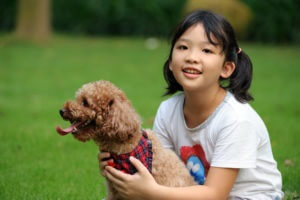Tips for Helping Your Children Learn to Live Safely with Pets
Are you thinking about adding a pet to your family? Congrats! Owning a pet can be a wonderful and fulfilling addition to your household. There are many benefits to owning a pet, especially if you have children. The American Academy of Child & Adolescent Psychiatry says that among other things, owning a pet can raise a child’s self-esteem and self-confidence, and teach them empathy and respect for other living things.

Though pet ownership provides many benefits, children must be taught how to interact with pets in a way that is safe and fun for every member of their household. Before you embark on your journey of pet ownership with kids, here are a few tips for you to keep in mind as you introduce a new member into your household.
Never Leave Your Young Child and Your Pet Unattended
Often, children and pets have different ways of communicating. Young children are likely to treat their pets as friends, which means they may try to play with them as if they were another human. This can sometimes mean being louder and more physical than your dog would prefer. The child may show affection by putting their face near your dog’s face, for example, which may seem threatening to your pet.
If you are in the room with your child, you can help guide your child to have appropriate interactions with your pet, and prevent your pet from becoming too agitated, thus preventing any possible issues, unpleasant experiences, or possible injuries.
Teach Your Children When to Approach Your Dog
Your child may be enthusiastic about playing with the family pet, but there are some times when your pet will want to be left alone. According to the RSPCA, your young child should steer clear of your pet when they are eating, sleeping, playing with a favorite toy, hurt, or can’t see or hear well. You want to give your dog space when they are engaging in these activities, as they are more likely to be defensive if they are interrupted or startled.
Teach Your Child to Read Your Pet’s Body Language
Helping a child learn to read your pet’s body language can be very beneficial for everyone in your family. Knowing when your dog is happy can show you that it’s ready to play or interact with you.
Dr. Sophia Yin, an expert in animal behavior, says, “Parents should also teach their children to read the signs that Fido is fearful or anxious so that the child knows to back off.” Just like people, dogs will sometimes need a break from loud or rambunctious behavior. Teaching your child how to understand what your dog is feeling will help your family and your pet to live harmoniously.
Never Allow Your Child to Approach an Unknown Dog
Children should never approach an unknown dog without permission. If your child wants to pet an unfamiliar dog, they should first ask the owner for permission. If permission is granted, the child should extend a closed hand first, to let the dog smell it. Then they may pet the dog slowly and gently on the dog’s shoulder or chest, taking care to avoid the dog’s head or face.
If your child sees a dog outside and alone without a leash, they should leave the dog alone and find an adult. Even if your child is comfortable around your family pet, it is important to remember that dog behaviors can vary wildly, especially around strangers, and it is important to practice caution when dealing with unfamiliar animals.
Teach Your Child to Play with Your Pet Appropriately
Dogs need to be treated with kindness and respect. When your child is interacting with your dog, ensure they are not playing with your pet more roughly than you would allow them to play with another child! Very young children may want to tug on your dog’s tail or pull on their ears. They may even want to climb on them and ride them like a horse! While children mean no harm by playing in this way, your dog may be threatened by it, and it could even lead to the dog becoming injured.
To avoid injuries and encourage behaviors the dog will like, teach your children how to play with the dog appropriately. When thinking of how to play with your pet, try to think of games that will minimize loud noises or roughhousing. Your dog may enjoy being taught new, simple tricks from your child, like sitting, shaking, or rolling over. They may enjoy playing fetch in the backyard or at a dog park or going on a treasure hunt for treats in your house. Model good behaviors for your children and reinforce them so that they can grow up to become the type of person who takes the best care of their pets possible.
Get Help From a Trained Professional
If you are unsure of appropriate games to teach your children to play with your pet, working with a dog trainer can be helpful. Greenlin Pet Resorts provides dog training in a group setting, and one-on-one classes are also available. Our goal is to help your life with your pet be as happy and safe as possible. We also offer doggie daycare for those days when your pet may need a break or a change in routine, as well as longer-term boarding. Our trained professionals will play and care for your dog in expansive fenced-in outdoor grassy spaces as well as our indoor climate-controlled, state-of-the-art facilities.
To find out more about our services, or book an appointment, reach out to a Greenlin Pet Resorts location near you.
